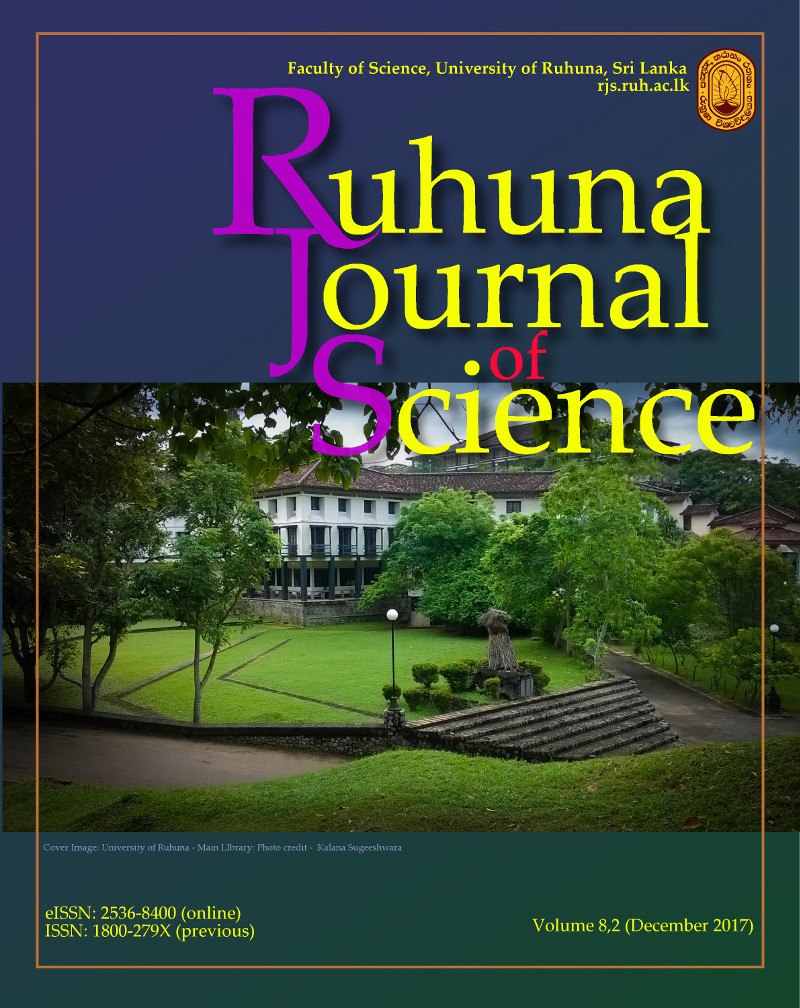Comparative GC-MS analysis of all Curcuma species grown in Sri Lanka by multivariate test
Abstract
Curcuma is clinically valuable genus in Traditional Medicine. People use various plants under the same vernacular name may lead to adulteration or substitution. Whole plants of Curcuma species were collected in 2016 in the flowering season. Voucher specimens of the plants were authenticated from the National Herbarium, Peradeniya. Essential oils were extracted from Clevenger’s apparatus and analyzed separately by GC-MS. The analyses were carried out with RTX WAX capillary column. Sampling and experiments were done according to WHO guidelines. One hundred sixty four phytochemicals were analyzed by simple correspondence and by cluster variable method. By cluster varibale as per phytochemicals present, mainly two groups were identified. C. albiflora and C. oligantha were identified as one group and the rest of the three plants were kept in the other group. A total of 64 constituents of essential oil obtained from whole plant of C. albiflora were identified by GC-MS, where α-pinene (10.87 %), caryophyllene oxide (8.85 %), alcanfor (5.12 %), aromadendrene oxide-(1) (4.81 %), n-hexadecanoic acid (4.74 %), α-famesene (3.93 %), camphene (3.52 %), and isoborneol (3.4 %) were detected as major compounds. The essential oil of C. aromatica possesses 7–methanoazulene (13.75 %) and curcumene (25.71%). Caryophyllene (15.07%), phytol (13.38%), humulene (8.24%), elemene (6.11%), caryophyllene oxide (5.82%) were found in C. oligantha. This preliminary study has identified chemical markers present in all Curcuma species grown in Sri Lanka. Keywords: Curcuma species, essential oils, GC-MS, multivariate.References
Abbasi K, Shah AA. 2015. Biological evaluation of Turmeric (Curcuma longa). International Journal of Current Microbiology and Applied Science 4(11): 236-249.
Afzal A, Oriqat G, Khan MA, Jose J, Afzal M. 2013. Chemistry and Biochemistry of Terpenoids from Curcuma and Related Species. Journal of Biologically Active Products from Nature 3(1): 1-55.
Amel B. 2015. Microscopic Analysis of Curcuma Longa L. Using Multivariate Test. International Journal of Pharmacognosy 2(4): 173-177.
Dassanayake MD. 1983. Flora of Ceylon, Vol. IV. Amerind Publishing Co. Pvt. Ltd, New Delhi 495 – 496, 501-504 pp.
Greenacre MJ. 1983. Correspondence Analysis in Practice. Academic Press, Harcourt, Brace & Company.
Krup V, Prakash HL, Harini A. 2013. Pharmacological Activities of Turmeric (Curcuma longa linn): A Review. Journal of Traditional Medicine & Clinical Naturopathy 2(133): 2167-1206.
Sikha A, Harini A, Prakash H. 2015. Pharmacological activities of wild turmeric (Curcuma aromatica Salisb): a review. Journal of Pharmacognosy and Phytochemistry 3(5): 01-04.
Tholkappiyavathi K, Selvan K, Neyanila M, Yoganandam SK, Gopal GP. 2013. A Concise Review on Curcuma Zedoaria. International Journal of Phytotherapy 3(1): 1-4.
WHO. 2012. Quality Control Methods for Medicinal Plant Materials. World Health Organization, Genève, 33-40 pp.
Downloads
Published
Issue
Section
License
From Volume 7 (2016) onwards, all articles published in Ruhuna Journal of Science are Open Access articles published under the Creative Commons CC BY-NC 4.0 International License. This License permits use, distribution and reproduction in any medium, provided the original work is properly cited and is not used for commercial purposes.
Copyright on any research article published in RJS is retained by the respective author(s).
Authors who publish with this journal agree to the following terms:
a) Authors retain copyright and grant the journal right of first publication with the work simultaneously licensed under a Creative Commons Attribution License CC-BY-NC 4.0 International, that allows others to share the work with an acknowledgement of the work's authorship and initial publication in this journal.
b) Authors are able to enter into separate, additional contractual arrangements for the non-exclusive distribution of the journal's published version of the work (e.g., post it to an institutional repository or publish it in a book), with an acknowledgement of its initial publication in this journal.
c) Authors are permitted and encouraged to post their work online (e.g., in institutional repositories or on their website) prior to and during the submission process, as it can lead to productive exchanges, as well as earlier and greater citation of published work (See The Effect of Open Access).

